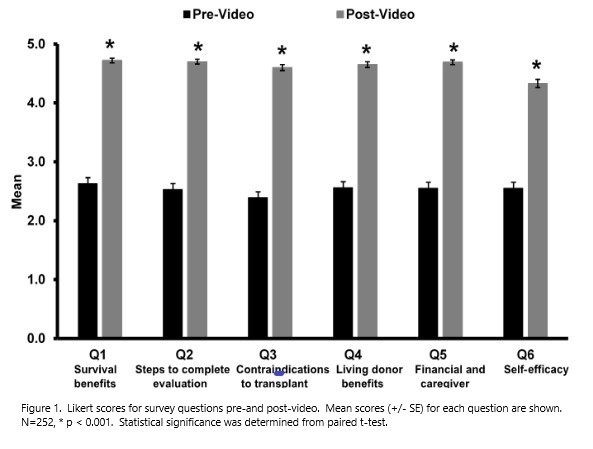A Video Education Intervention to Improve Kidney Transplant Knowledge and Self-Efficacy in Dialysis Center End Stage Renal Disease (ESRD) Patients
1Medical University of South Carolina`, Charleston, SC, 2Departments of Surgery and Psychiatry, Beth Israel Deaconiess Medical Center, Boston, MA, 3Department of Surgery, Medical University of South Carolina`, Charleston, SC
Meeting: 2020 American Transplant Congress
Abstract number: LB-014
Keywords: Kidney transplantation, N/A, Patient education, Waiting lists
Session Information
Session Name: Poster Session A: Late Breaking
Session Type: Poster Session
Date: Saturday, May 30, 2020
Session Time: 3:15pm-4:00pm
 Presentation Time: 3:30pm-4:00pm
Presentation Time: 3:30pm-4:00pm
Location: Virtual
*Purpose: Only 34% of incident ESRD patients are referred for transplant (Tx) evaluation within 12 months of initiating dialysis. There is great need for effective interventions to encourage Tx referral for prevalent ESRD populations. In this quality improvement (QI) initiative, we measured whether a dialysis center-based educational intervention increased patients’ self-assessed Tx knowledge and self-efficacy, resulting in increased Tx referrals.
*Methods: During center-based hemodialysis, patients who had not completed a Tx evaluation were provided a 12-minute iPad-based Tx education video. Questionnaires assessed patient demographics and self-assessed Tx knowledge (questions included; #1-survival benefit of Tx, #2-steps to complete Tx evaluation, #3-Tx exclusion criteria, #4-living donation, #5-financial and caregiver requirements); as well as a single self-efficacy question “I feel prepared to initiate a Tx work-up”. Questions were measured at baseline and after the intervention on a 5-point Likert scale. Rates of Tx referral per dialysis clinic were compared before and after the intervention.
*Results: Of 340 dialysis patients approached at 13 centers in a Southern state, 252 met study criteria, agreed to participate, and completed both pre- and post-video components (77% African American; AA). The overall (all questions averaged) Likert score increased from 2.53 ± 0.10 to 4.62 ± 0.05, p<0.01 (Figure 1). There were no differences in change of self-efficacy observed between AA and Caucasians. At baseline, lower self-efficacy was observed in patients with < high school education or located > 50 miles from Tx center. The intervention abrogated these education and distance disparities. Rates of Tx referral increased 101% following the intervention (4.7 +/- 4.2 vs 9.4 +/- 3.8 referrals/100 patient yr, p = 0.0008).
*Conclusions: This QI initiative produced a significant increase in dialysis patients’ self-assessed Tx knowledge and self-efficacy, while also eliminating educational and distance disparities. Significant increases in Tx referrals were observed after the intervention. Additional time is required to see if the increased referrals observed after the intervention translate into increased evaluations initiated and waitlist entries.
To cite this abstract in AMA style:
DuBay DA, Morinelli T, Sutton Z, Chastain M, Tindal TThompkins, Su Z, Weeda E, Mauldin P, Casey M, Bian J, Rodrigue J, Baliga P, Taber D. A Video Education Intervention to Improve Kidney Transplant Knowledge and Self-Efficacy in Dialysis Center End Stage Renal Disease (ESRD) Patients [abstract]. Am J Transplant. 2020; 20 (suppl 3). https://atcmeetingabstracts.com/abstract/a-video-education-intervention-to-improve-kidney-transplant-knowledge-and-self-efficacy-in-dialysis-center-end-stage-renal-disease-esrd-patients/. Accessed January 1, 2026.« Back to 2020 American Transplant Congress

